Spatial and Temporal Matching Measurement of Ecosystem Service Supply, Demand and Human Well-Being and Its Coordination in the Great Rivers Economic Belt—Evidence from China’s Yangtze River Economic Belt
Abstract
:1. Introduction
2. Materials and Methods
2.1. Study Area
2.2. Data Sources
2.3. Method
2.3.1. Methodological Framework
2.3.2. Land Use Transfer Matrix
2.3.3. Calculation of Supply and Demand for Ecological Services
Water Yield
Carbon Sequestration
Soil Conservation
Food Supply
Supply and Demand Analysis of Ecological Services
2.3.4. Human Well-Being Measurements
2.3.5. Coupling Coordination Model
2.3.6. Spatial Autocorrelation Analysis
3. Results
3.1. Analysis of Land Use Change in the YZRB
3.2. Analysis of Temporal and Spatial Variations in ESSD in the YZRB
3.3. Analysis of Temporal and Spatial Changes in the ESCP in the YZRB
3.4. Analysis of Spatial and Temporal Changes in Human Wellbeing in the YZRB
3.5. Spatiotemporal Analysis of the Coupling Coordination between ESCP and Com WB in the YZRB
3.6. Analysis of Spatial Autocorrelation Results
4. Discussion
4.1. ESSD and Increasing Levels of Human Well-Being
4.2. Exploration of Coordination Issues in Ecosystem Governance and Human Well-Being
4.3. Recommendations for Promoting Ecological Conservation and Human Well-Being
4.4. Innovations and Limitations
5. Conclusions
Author Contributions
Funding
Institutional Review Board Statement
Informed Consent Statement
Data Availability Statement
Conflicts of Interest
References
- Daily, G.; Dasgupta, S. Ecosystem Services, Concept of. In Encyclopedia of Biodiversity; Levin, S.A., Ed.; Elsevier: New York, NY, USA, 2001; pp. 353–362. [Google Scholar]
- Guo, Z.; Xiao, X.; Gan, Y.; Zheng, Y. Ecosystem functions, services and their values—A case study in Xingshan County of China. Ecol. Econ. 2001, 38, 141–154. [Google Scholar] [CrossRef]
- Reid, W.V.; Mooney, H.A. The Millennium Ecosystem Assessment: Testing the limits of interdisciplinary and multi-scale science. Curr. Opin. Env. Sust. 2016, 19, 40–46. [Google Scholar] [CrossRef]
- Wang, Y.; Sun, J.; Liu, C.; Liu, L. Exploring the nexus between perceived ecosystem services and well-being of rural residents in a mountainous area, China. Appl. Geogr. 2024, 164, 103215. [Google Scholar] [CrossRef]
- Burkhard, B.; Petrosillo, I.; Costanza, R. Ecosystem services—Bridging ecology, economy and social sciences. Ecol. Complex. 2010, 7, 257–259. [Google Scholar] [CrossRef]
- Mancini, M.S.; Galli, A.; Coscieme, L.; Niccolucci, V.; Lin, D.; Pulselli, F.M.; Bastianoni, S.; Marchettini, N. Exploring ecosystem services assessment through Ecological Footprint accounting. Ecosyst. Serv. 2018, 30, 228–235. [Google Scholar] [CrossRef]
- Li, S.; Yu, D.; Li, X. Exploring the impacts of ecosystem services on human well-being in Qinghai Province under the framework of the sustainable development goals. J. Environ. Manag. 2023, 345, 118880. [Google Scholar] [CrossRef]
- Xu, Y.; Liu, Y.; Sun, Q.; Qi, W. Construction of Cultivated Land Ecological Network Based on Supply and Demand of Ecosystem Services and MCR Model: A Case Study of Shandong Province, China. Sustainability 2024, 16, 3745. [Google Scholar] [CrossRef]
- Xue, B.; Han, B.; Li, H.; Gou, X.; Yang, H.; Thomas, H.; Stückrad, S. Understanding ecological civilization in China: From political context to science. Ambio 2023, 52, 1895–1909. [Google Scholar] [CrossRef]
- Hansen, M.H.; Li, H.; Svarverud, R. Ecological civilization: Interpreting the Chinese past, projecting the global future. Glob. Environ. Chang. 2018, 53, 195–203. [Google Scholar] [CrossRef]
- Zhang, C.; Li, J.; Zhou, Z. Ecosystem service cascade: Concept, review, application and prospect. Ecol. Indic. 2022, 137, 108766. [Google Scholar] [CrossRef]
- Huang, X.; Chen, Y.; Ma, J.; Chen, Y. Study on change in value of ecosystem service function of Tarim River. Acta Ecol. Sin. 2010, 30, 67–75. [Google Scholar] [CrossRef]
- Bai, Y.; Zhuang, C.; Ouyang, Z.; Zheng, H.; Jiang, B. Spatial characteristics between biodiversity and ecosystem services in a human-dominated watershed. Ecol. Complex. 2011, 8, 177–183. [Google Scholar] [CrossRef]
- Wegner, G.; Pascual, U. Cost-benefit analysis in the context of ecosystem services for human well-being: A multidisciplinary critique. Glob. Environ. Chang. 2011, 21, 492–504. [Google Scholar] [CrossRef]
- Zeng, J.; Cui, X.; Chen, W.; Yao, X. Ecological management zoning based on the supply-demand relationship of ecosystem services in China. Appl. Geogr. 2023, 155, 102959. [Google Scholar] [CrossRef]
- Zheng, P.; Jin, L.; Huang, Y.; Pan, W. Spatial and Temporal Dynamic Evolution and Correlation of Ecological Quality and Ecosystem Service Value in Fujian Province. Sustainability 2024, 16, 5063. [Google Scholar] [CrossRef]
- He, L.; Zhang, X.; Zhang, X. Urbanization with the pursuit of efficiency and ecology: Theory and evidence from China. Environ. Impact Assess. Rev. 2023, 103, 107274. [Google Scholar] [CrossRef]
- Wang, M.; Huang, H.; Xiong, J.; Yuan, Z.; Zeng, K. Impact of ecological reserves on the local residents’ health: Evidence from a natural experiment in China. Soc. Sci. Med. 2023, 336, 116186. [Google Scholar] [CrossRef]
- Wu, J. Urban ecology and sustainability: The state-of-the-science and future directions. Landsc. Urban Plan 2014, 125, 209–221. [Google Scholar] [CrossRef]
- Costanza, R.; D’Arge, R.; de Groot, R.; Farber, S.; Grasso, M.; Hannon, B.; Limburg, K.; Naeem, S.; O’Neill, R.V.; Paruelo, J.; et al. The value of the world’s ecosystem services and natural capital. Nature 1997, 387, 253–260. [Google Scholar] [CrossRef]
- Zhou, Y.; Huang, Q.; Wu, P.; Hou, Y.; Zhou, Y.; Chen, P.; Duan, X. Seasonal variations in ecosystem service supply and demand based on the SWAT model: A case study in the Guanting Reservoir Basin, China. Ecol. Indic. 2024, 158, 111552. [Google Scholar] [CrossRef]
- Liu, L.; Bao, S.; Han, M.; Li, H.; Hu, Y.; Zhang, L. Dynamic Spatio-Temporal Simulation of Land Use and Ecosystem Service Value Assessment in Agro-Pastoral Ecotone, China. Sustainability 2024, 16, 5922. [Google Scholar] [CrossRef]
- Jian, Z.; Sun, Y.; Wang, F.; Zhou, C.; Pan, F.; Meng, W.; Sui, M. Soil conservation ecosystem service supply-demand and multi scenario simulation in the Loess Plateau, China. Glob. Ecol. Conserv. 2024, 49, e02796. [Google Scholar] [CrossRef]
- Xie, Y.; Dai, W.; Xiang, S.; Deng, H.; Wang, Z.; Li, Y.; Wang, Z.; Zhou, M.; Gao, M. Supply and demand of ecosystem services and their interaction with urbanization: The case of Chengdu-Chongqing urban agglomeration. Urban Clim. 2024, 55, 101978. [Google Scholar] [CrossRef]
- Daigneault, A.; Simons-Legaard, E.; Weiskittel, A. Tradeoffs and synergies of optimized management for maximizing carbon sequestration across complex landscapes and diverse ecosystem services. Forest Policy Econ. 2024, 161, 103178. [Google Scholar] [CrossRef]
- Wu, C.; Lu, R.; Zhang, P.; Dai, E. Multilevel ecological compensation policy design based on ecosystem service flow: A case study of carbon sequestration services in the Qinghai-Tibet Plateau. Sci. Total Environ. 2024, 921, 171093. [Google Scholar] [CrossRef]
- Yang, X.; Luo, J. Construction of territorial spatial ecological network oriented to residents’ ecological well-being: Take Nanchang City as an example. Acta Agric. Univ. Jiangxiensis 2023, 45, 1297–1310. [Google Scholar] [CrossRef]
- Gao, G.; Liang, Y.; Liu, J.; Dunkerley, D.; Fu, B. A modified RUSLE model to simulate soil erosion under different ecological restoration types in the loess hilly area. Int. Soil Water Conserv. 2024, 12, 258–266. [Google Scholar] [CrossRef]
- Perschke, M.J.; Harris, L.R.; Sink, K.J.; Lombard, A.T. Using ecological infrastructure to comprehensively map ecosystem service demand, flow and capacity for spatial assessment and planning. Ecosyst. Serv. 2023, 62, 101536. [Google Scholar] [CrossRef]
- Qu, H.; You, C.; Feng, C.; Guo, L. Spatial responses of ecosystem services to carbon emission efficiency based on spatial panel models in the Yangtze River Economic Belt. J. Clean. Prod. 2024, 434, 139953. [Google Scholar] [CrossRef]
- Sisay, G.; Gessesse, B.; Fürst, C.; Kassie, M.; Kebede, B.; Alemu, W.G. Evaluating the spatiotemporal dynamics of ecosystem service values in response to land use/land cover change in Goang watershed, Northwest Ethiopia. Environ. Chall. 2024, 15, 100908. [Google Scholar] [CrossRef]
- Liu, Z.; Zhang, W.; Lu, H.; Ji, J.; Yang, Z.; Chen, C. Exploring evolution characteristics of eco-environment quality in the Yangtze River Basin based on remote sensing ecological index. Heliyon 2023, 9, e23243. [Google Scholar] [CrossRef]
- Liu, S.; Wang, C.; Chen, Z.; Li, Q.; Wu, Q.; Li, Y.; Wu, J.; Yu, B. Enhancing nighttime light remote Sensing: Introducing the nighttime light background value (NLBV) for urban applications. Int. J. Appl. Earth Obs. 2024, 126, 103626. [Google Scholar] [CrossRef]
- Li, Y.; Geng, H.; Luo, G.; Wu, L.; Wang, J.; Wu, Q. Multiscale characteristics of ecosystem service value trade-offs/synergies and their response to landscape pattern evolution in a typical karst basin in southern China. Ecol. Inform. 2024, 81, 102584. [Google Scholar] [CrossRef]
- Zhang, C.; Yang, G.; Chen, D.; Zhang, H. Spatiotemporal coupling relationship between supply-demand balance of ecosystem services and welfare of residents in the Middle Reaches of the Yangtze River. Trans. Chin. Soc. Agric. Eng. 2024, 40, 356–368. [Google Scholar]
- Mitchell, A.; Larson, K.L.; Pfeiffer, D.; Rosales Chavez, J. Planning for Urban Sustainability through Residents’ Wellbeing: The Effects of Nature Interactions, Social Capital, and Socio-Demographic Factors. Sustainability 2024, 16, 4160. [Google Scholar] [CrossRef]
- Tao, J.; Lu, Y.; Ge, D.; Dong, P.; Gong, X.; Ma, X. The spatial pattern of agricultural ecosystem services from the production-living-ecology perspective: A case study of the Huaihai Economic Zone, China. Land Use Policy 2022, 122, 106355. [Google Scholar] [CrossRef]
- Zhang, K.; Jin, Y.; Li, D.; Wang, S.; Liu, W. Spatiotemporal variation and evolutionary analysis of the coupling coordination between urban social-economic development and ecological environments in the Yangtze River Delta cities. Sustain. Cities Soc. 2024, 111, 105561. [Google Scholar] [CrossRef]
- He, L.; Xie, Z.; Wu, H.; Liu, Z.; Zheng, B.; Wan, W. Exploring the interrelations and driving factors among typical ecosystem services in the Yangtze river economic Belt, China. J. Environ. Manag. 2024, 351, 119794. [Google Scholar] [CrossRef]
- Yang, L.; Zhou, X.; Gu, X.; Liang, Y. Impact mechanism of ecosystem services on resident well-being under sustainable development goals: A case study of the Shanghai metropolitan area. Environ. Impact Asses. 2023, 103, 107262. [Google Scholar] [CrossRef]
- Jiang, W.; Guo, P.; Lin, Z.; Fu, Y.; Li, Y.; Kasperkiewicz, K.; Gaafar, A.Z. Factors influencing the spatiotemporal variation in the value of ecosystem services in Anxi county. Heliyon 2023, 9, e19182. [Google Scholar] [CrossRef]
- An, M.; Wu, Y.; Ouyang, Y.; Song, M.; Huang, J.; Dong, X.; Thomas Stephen, R. Spatial-Temporal evolvement and the contributing factors for the economic potential of ecosystem services in counties situated along a river. J. Nat. Conserv. 2023, 75, 126461. [Google Scholar] [CrossRef]
- Yang, J.; Huang, X. The 30 m annual land cover dataset and its dynamics in China from 1990 to 2019. Earth Syst. Sci. Data 2021, 13, 3907–3925. [Google Scholar] [CrossRef]
- Peng, S. 1-km monthly precipitation dataset for China (1901–2022). In National Tibetan Plateau Data Center; Institute of Tibetan Plateau Research, Chinese Academy of Sciences: Beijing, China, 2020. [Google Scholar]
- Peng, S. China’s 1km Monthly Potential Evapotranspiration Dataset (1901–2022). In National Qinghai Tibet Plateau Scientific Data Center; Institute of Soil and Water Conservation, Northwest A&F University: Yangling, China, 2022. [Google Scholar]
- Hengl, T.; Mendes De Jesus, J.; Heuvelink, G.B.M.; Ruiperez Gonzalez, M.; Kilibarda, M.; Blagoti, A.; Shangguan, W.; Wright, M.N.; Geng, X.; Bauer-Marschallinger, B.; et al. SoilGrids250m: Global gridded soil information based on machine learning. PLoS ONE 2017, 12, e0169748. [Google Scholar] [CrossRef] [PubMed]
- Yang, Z. Comparison and empirical analysis of the urban economic development level in the Yangtze River urban agglomeration based on an analogical ecosystem perspective. Ecol. Inform. 2021, 64, 101321. [Google Scholar] [CrossRef]
- Warsi, O.M.; Dykhuizen, D.E. Evolutionary implications of Liebig’s law of the minimum: Selection under low concentrations of two nonsubstitutable nutrients. Ecol. Evol. 2017, 7, 5296–5309. [Google Scholar] [CrossRef]
- Tsuyoshi, G.; Genki, Y. Debt issuance incentives and creative accounting: Evidence from municipal mergers in Japan. J. Jpn. Int. Econ. 2023, 68, 101259. [Google Scholar]
- Jansson, M.; Schneider, J. The Welfare Landscape and Densification—Residents’ Relations to Local Outdoor Environments Affected by Infill Development. Land 2023, 12, 2021. [Google Scholar] [CrossRef]
- Yang, X.; Xiong, C.; Han, W.; Yang, Y. Analysis of the impacts of carbon neutral policy portfolios on the economy, environment, and residents’ welfare based on computable general equilibrium models. J. Clean. Prod. 2024, 458, 142288. [Google Scholar] [CrossRef]
- Rui, D.; Yuqi, Z.; Siwei, S.; Du, L.; Jun, F.; Jian, Z.; Lina, P. Does Urban Shrinkage Inhibit Residents’ Welfare? From the Perspective of Urban–Rural Development in China. Soc. Indic. Res. 2024, 171, 847–876. [Google Scholar]
- Congxian, H.; Can, Z.; Huwei, W. Improving the consumer welfare of rural residents through public support policies: A study on old revolutionary areas in China. Socio-Econ. Plan Sci. 2024, 91, 101767. [Google Scholar]
- Yangyi, Z.; Yuanying, C.; Guozheng, L.; Xufeng, Z. The impact of carbon tax policy on residents’ welfare of China and its heterogeneity under the carbon neutrality goal: A CGE model-based analysis. J. Clean Prod. 2024, 434, 140442. [Google Scholar]
- Deng, H.; Hu, J. A comparative analysis of the coupling and coordination between the ecological civilization construction and tourism development in different types of resource-based cities. J. Nat. Conserv. 2024, 79, 126563. [Google Scholar] [CrossRef]
- Dong, Q.; Zhong, K.; Liao, Y.; Xiong, R.; Wang, F.; Pang, M. Coupling coordination degree of environment, energy, and economic growth in resource-based provinces of China. Resour. Policy 2023, 81, 103308. [Google Scholar] [CrossRef]
- Sun, J.; Zhai, N.; Mu, H.; Miao, J.; Li, W.; Li, M. Assessment of urban resilience and subsystem coupling coordination in the Beijing-Tianjin-Hebei urban agglomeration. Sustain. Cities Soc. 2024, 100, 105058. [Google Scholar] [CrossRef]
- Wang, H.; Xu, Y.; Li, C. Coupling coordination and spatio-temporal pattern evolution between ecological protection and high-quality development in the Yellow River Basin. Heliyon 2023, 9, e21089. [Google Scholar] [CrossRef] [PubMed]
- Wu, H.; Deng, H.; Gao, X. Corporate coupling coordination between ESG and financial performance: Evidence from China’s listed companies. Environ. Impact Asses. 2024, 107, 107546. [Google Scholar] [CrossRef]
- Zhong, Q.; Fu, H.; Yan, J.; Li, Z. How does energy utilization affect rural sustainability development in traditional villages? Re-examination from the coupling coordination degree of atmosphere-ecology-socioeconomics system. Build. Environ. 2024, 257, 111541. [Google Scholar] [CrossRef]
- Shi, J.; Li, S.; Liu, M.; Li, X.; Yan, H.; Dong, C. Ecological well-being and its equity in various economic contexts: Evidence from 130 cities in the yangtze river economic belt. Ecol. Indic. 2023, 156, 111093. [Google Scholar] [CrossRef]
- Fan, S.; Yan, M.; Yu, L.; Chen, B.; Zhang, L. Integrating ecosystem service supply–demand and ecological risk assessment for urban planning: A case study in Beijing, China. Ecol. Indic. 2024, 161, 111950. [Google Scholar] [CrossRef]
- Pan, Z.; He, J.; Liu, D.; Wang, J.; Guo, X. Ecosystem health assessment based on ecological integrity and ecosystem services demand in the Middle Reaches of the Yangtze River Economic Belt, China. Sci. Total Environ. 2021, 774, 144837. [Google Scholar] [CrossRef]
- Li, J.; Jiang, H.; Bai, Y.; Alatalo, J.M.; Li, X.; Jiang, H.; Liu, G.; Xu, J. Indicators for spatial–temporal comparisons of ecosystem service status between regions: A case study of the Taihu River Basin, China. Ecol. Indic. 2016, 60, 1008–1016. [Google Scholar] [CrossRef]
- Lee, S. Developing a bivariate spatial association measure: An integration of Pearson’s r and Moran’s I. J. Geogr. Syst. 2001, 3, 369–385. [Google Scholar] [CrossRef]
- Feng, Y.; Sun, M.; Pan, Y.; Zhang, C. Fostering inclusive green growth in China: Identifying the impact of the regional integration strategy of Yangtze River Economic Belt. J. Environ. Manag. 2024, 358, 120952. [Google Scholar] [CrossRef] [PubMed]
- She, Y.; Liu, Y.; Jiang, L.; Yuan, H. Is China’s River Chief Policy effective? Evidence from a quasi-natural experiment in the Yangtze River Economic Belt, China. J. Clean. Prod. 2019, 220, 919–930. [Google Scholar] [CrossRef]
- Ma, S.; Wen, Z. Optimization of land use structure to balance economic benefits and ecosystem services under uncertainties: A case study in Wuhan, China. J. Clean. Prod. 2021, 311, 127537. [Google Scholar] [CrossRef]
- Zhang, Z.; Fang, F.; Cheng, X.; Huang, C. Interactions of socioecological factors on the supply–demand balance of ecosystem services in the Yangtze River Economic Belt, China. Watershed Ecol. Environ. 2024, 6, 125–137. [Google Scholar] [CrossRef]
- Fang, L.; Wang, L.; Chen, W.; Sun, J.; Cao, Q.; Wang, S.; Wang, L. Identifying the impacts of natural and human factors on ecosystem service in the Yangtze and Yellow River Basins. J. Clean. Prod. 2021, 314, 127995. [Google Scholar] [CrossRef]
- Ji, R.; Wang, C.; Wang, P.; Wang, W.; Chen, N. Quantitative analysis of spatiotemporal disparity of urban water use efficiency and its driving factors in the Yangtze River Economic Belt, China. J. Hydrol. Reg. Stud. 2024, 51, 101647. [Google Scholar] [CrossRef]
- Li, B.; Wan, R.; Yang, G.; Yang, S.; Dong, L.; Cui, J.; Zhang, T. Centennial loss of lake wetlands in the Yangtze Plain, China: Impacts of land use changes accompanied by hydrological connectivity loss. Water Res. 2024, 256, 121578. [Google Scholar] [CrossRef]
- Peng, Y.; Welden, N.; Renaud, F.G. Incorporating ecosystem services into comparative vulnerability and risk assessments in the Pearl River and Yangtze River Deltas, China. Ocean Coast Manag. 2024, 249, 106980. [Google Scholar] [CrossRef]
- Wu, X.; Yue, Y.; Borthwick, A.G.L.; Slater, L.J.; Syvitski, J.; Bi, N.; Yang, Z.; Wang, H. Mega-reservoir regulation: A comparative study on downstream responses of the Yangtze and Yellow rivers. Earth-Sci. Rev. 2023, 245, 104567. [Google Scholar] [CrossRef]
- Dan, L.; Qianwen, G.; Wenjie, Y. The Evolution of Farmland Protection Policy and Optimization Path from 1978 to 2018. Chin. Rural Econ. 2018, 12, 37–51. [Google Scholar]
- Hu, H.; Yan, K.; Shi, Y.; Lv, T.; Zhang, X.; Wang, X. Decrypting resilience: The spatiotemporal evolution and driving factors of ecological resilience in the Yangtze River Delta Urban Agglomeration. Environ. Impact Asses. 2024, 106, 107540. [Google Scholar] [CrossRef]
- Tang, T.; Lin, X.; Lu, M. Analysis of the dynamic mechanism of trans-boundary pollution collaborative control in the Yangtze River Economic Belt. Environ. Res. 2024, 257, 119327. [Google Scholar] [CrossRef]
- Liu, T.; Song, Q.; Lu, J.; Qi, Y. An integrated approach to evaluating the coupling coordination degree between low-carbon development and air quality in Chinese cities. Adv. Clim. Chang. Res. 2021, 12, 710–722. [Google Scholar] [CrossRef]
- Wang, S.; Kong, W.; Ren, L.; Zhi, D.; Dai, B. Research on misuses and modification of coupling coordination degree model in China. J. Nat. Resour. 2021, 36, 793. [Google Scholar] [CrossRef]
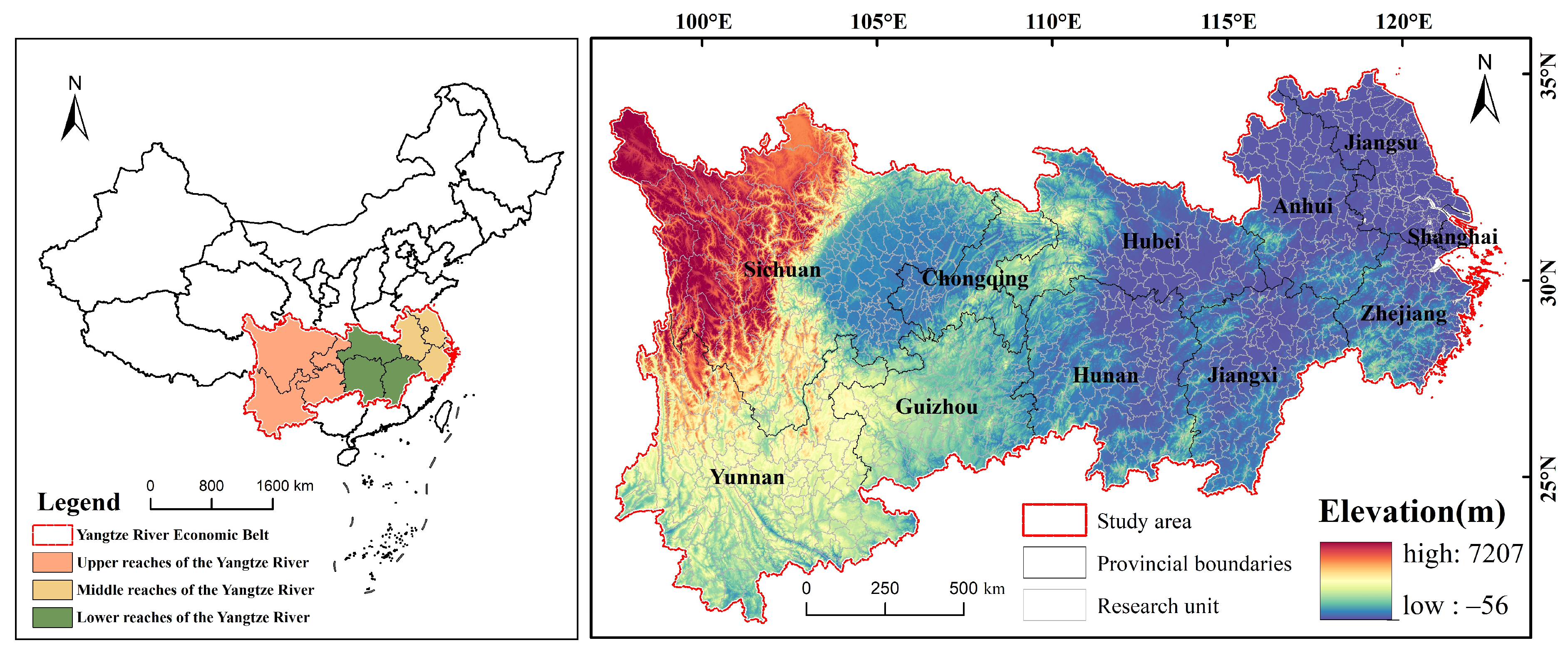
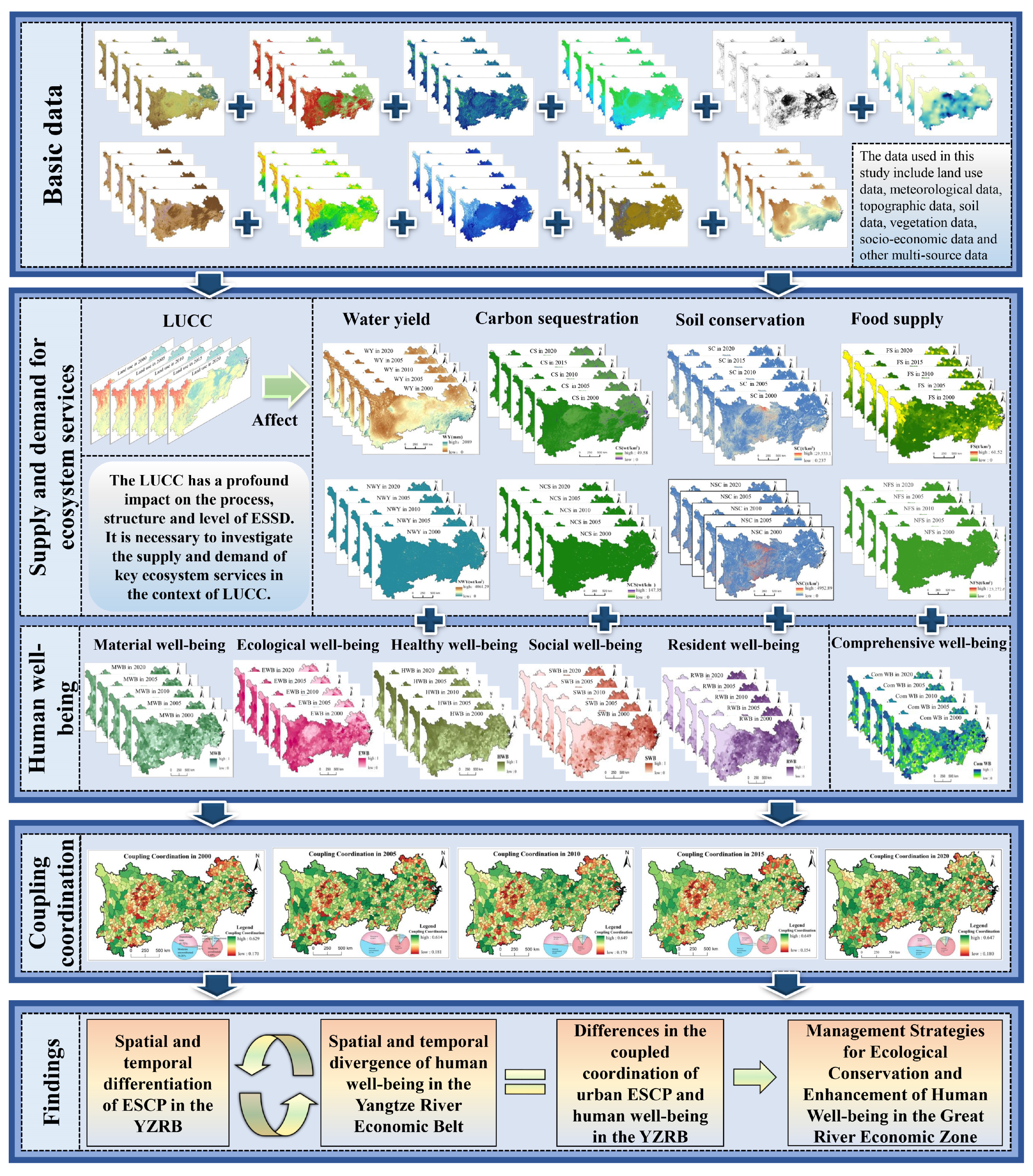
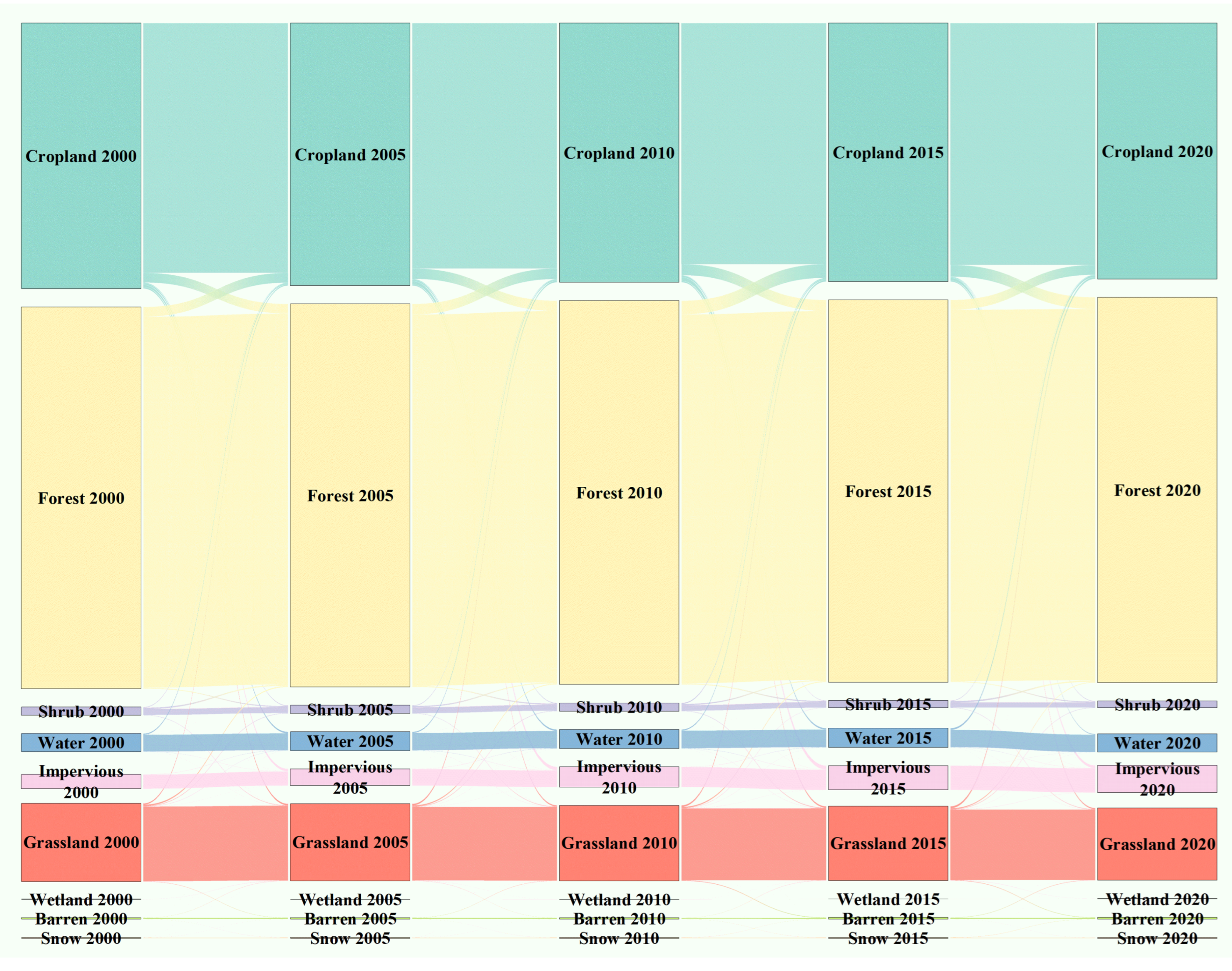


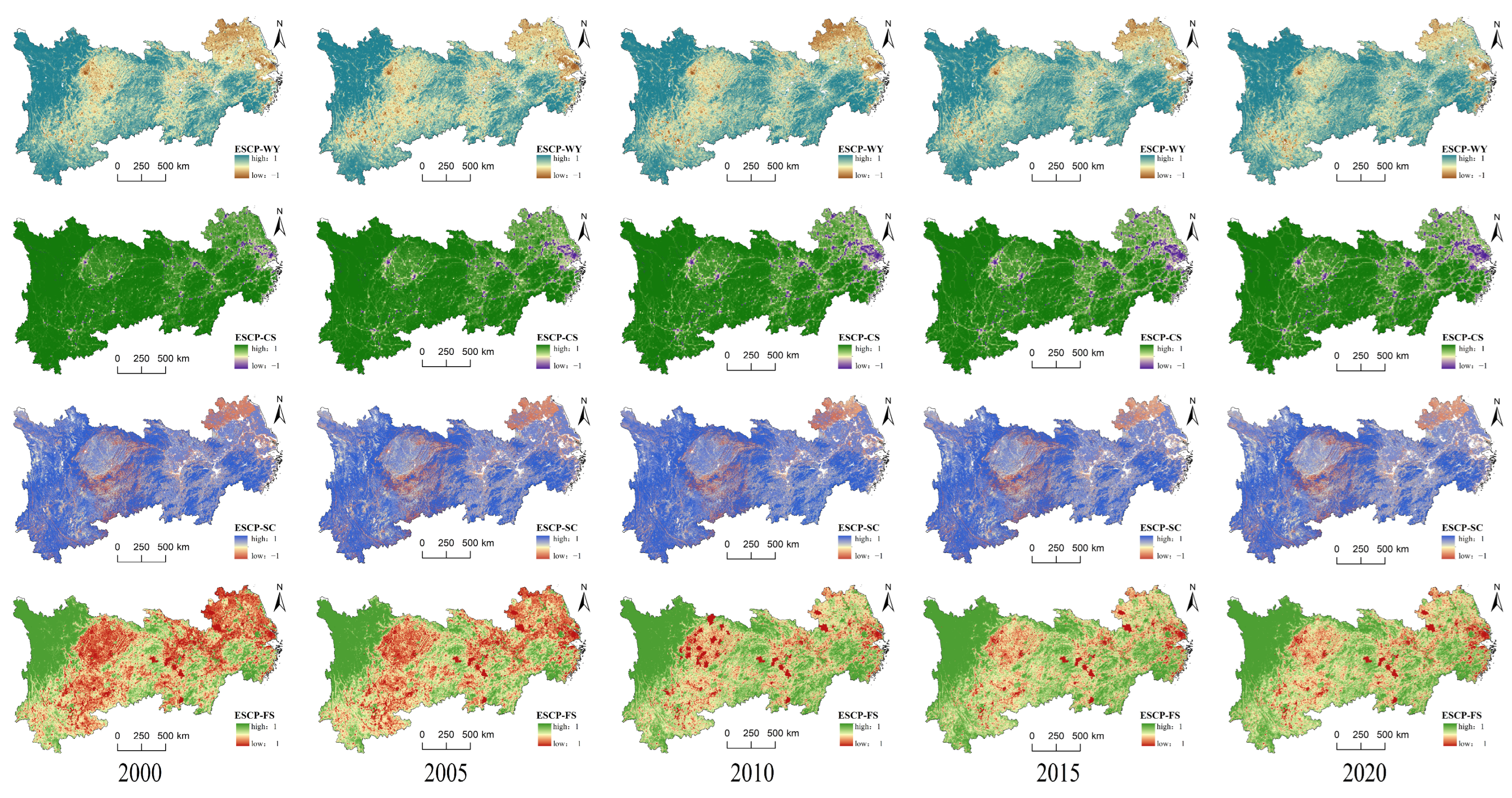
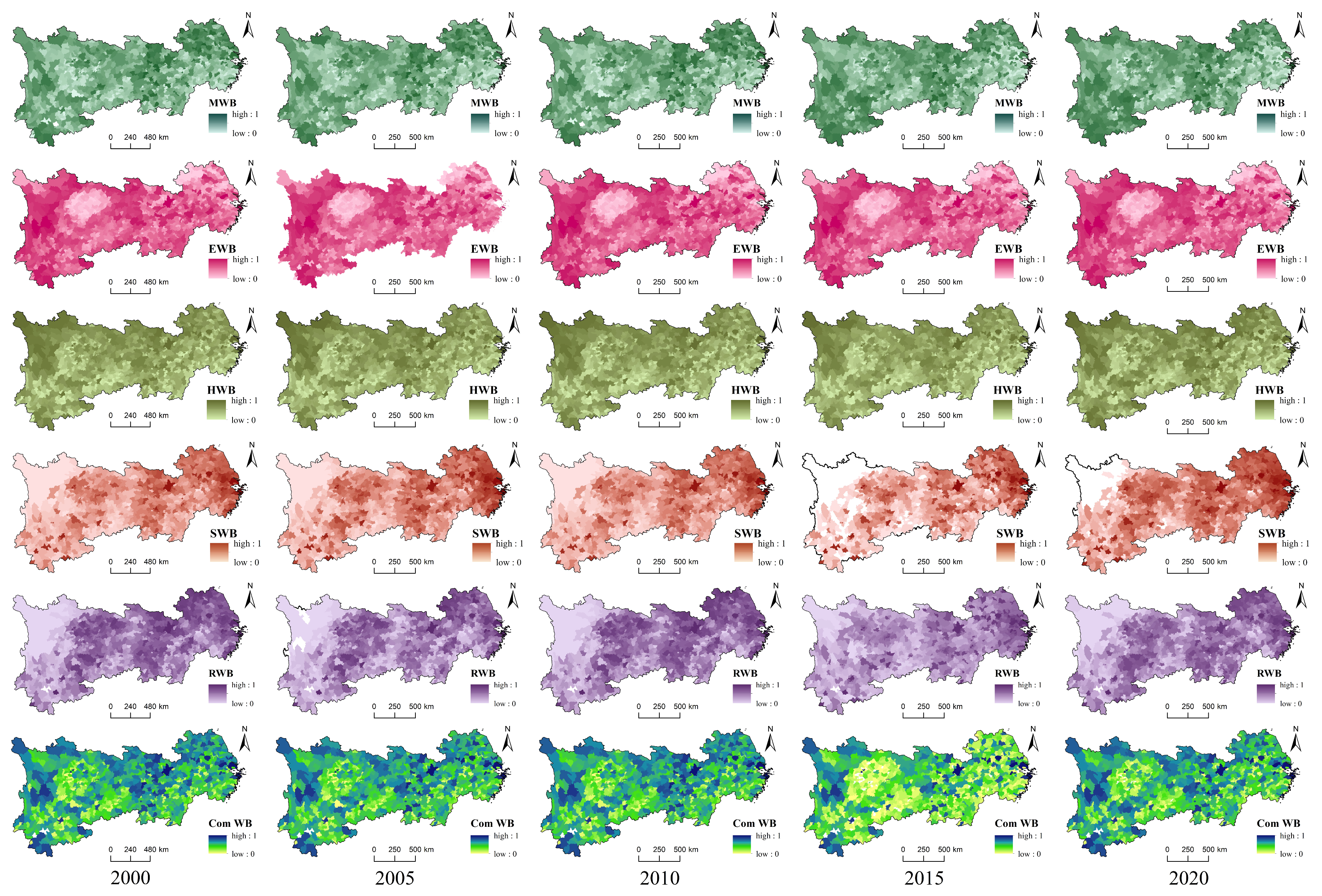
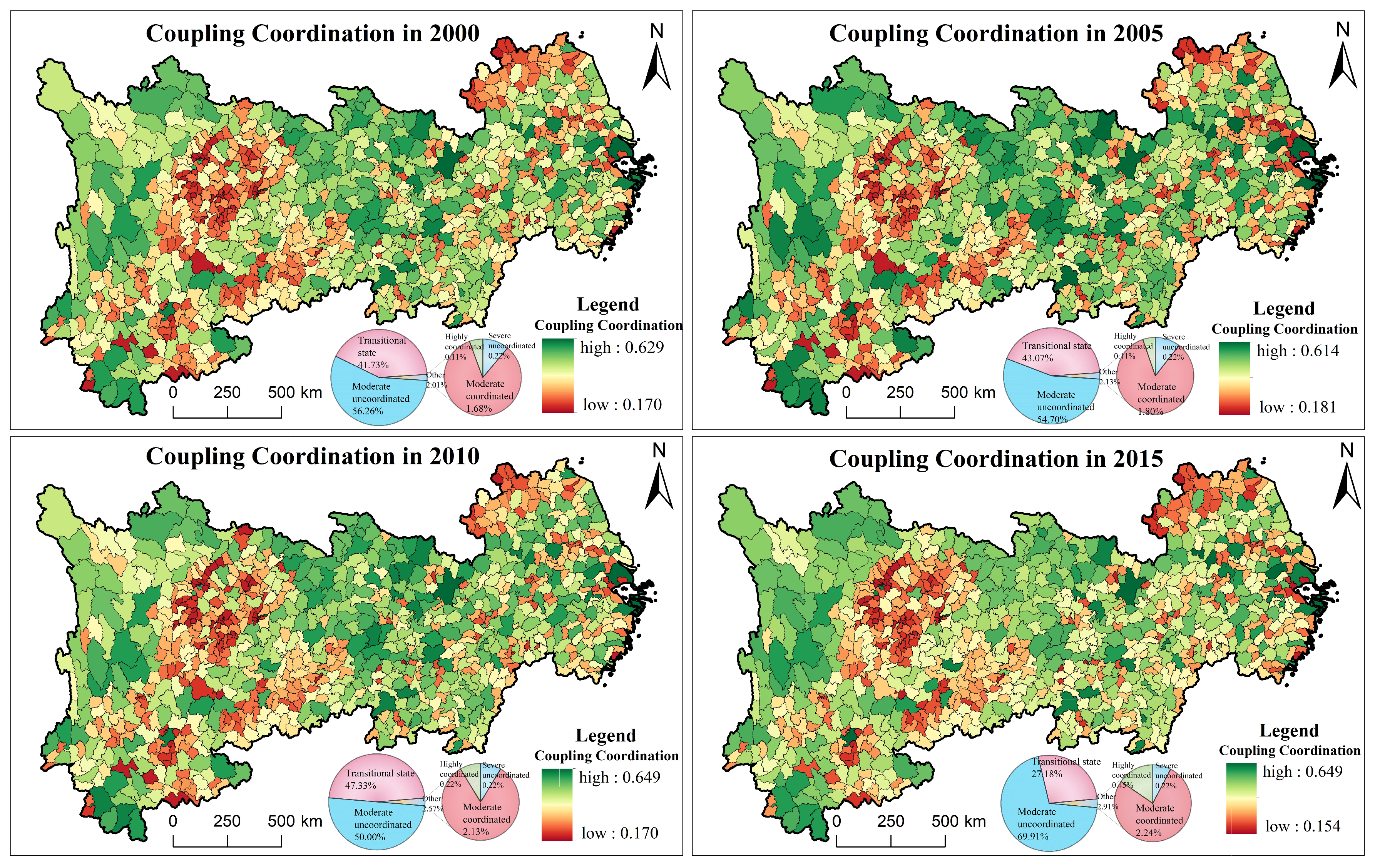
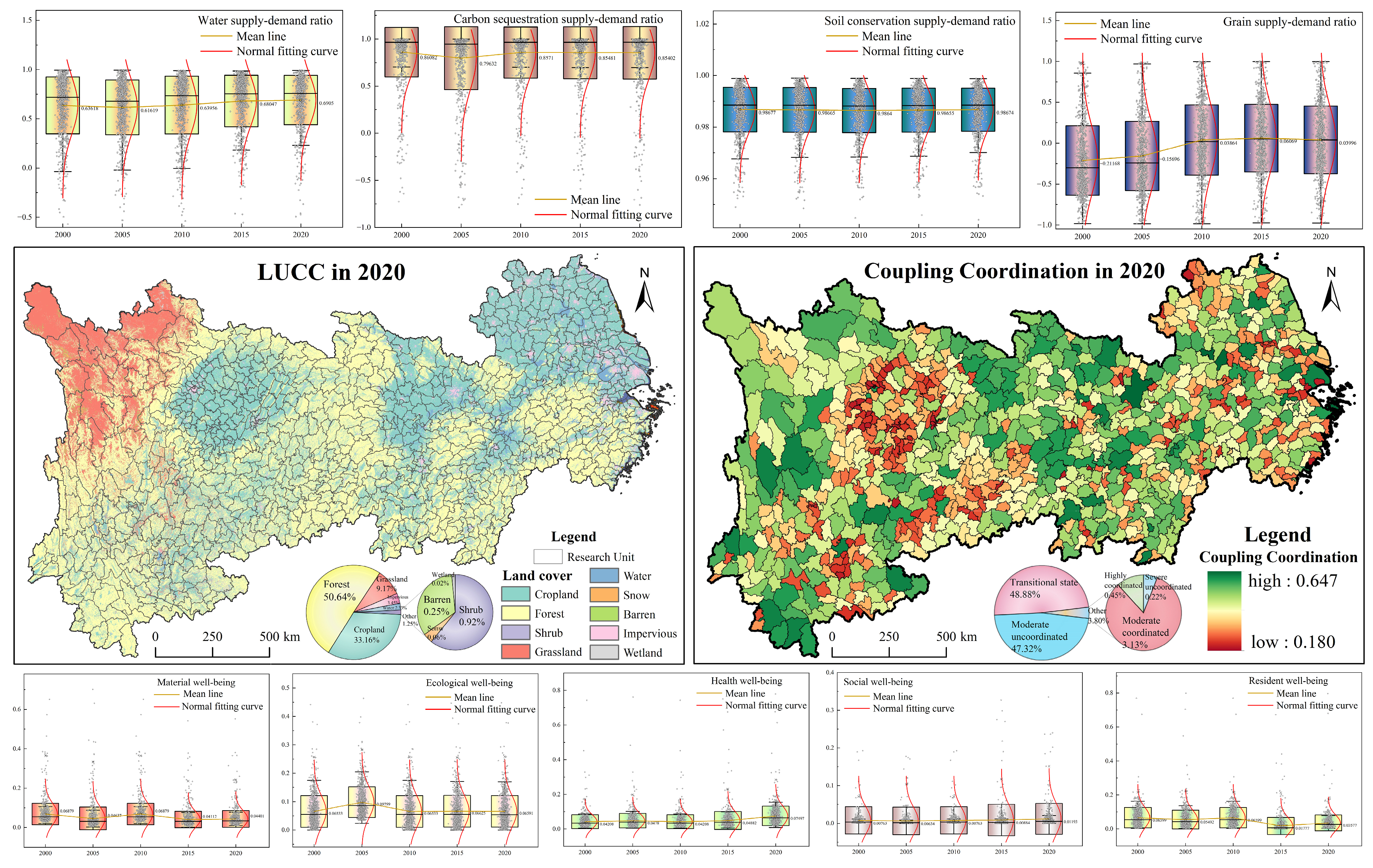
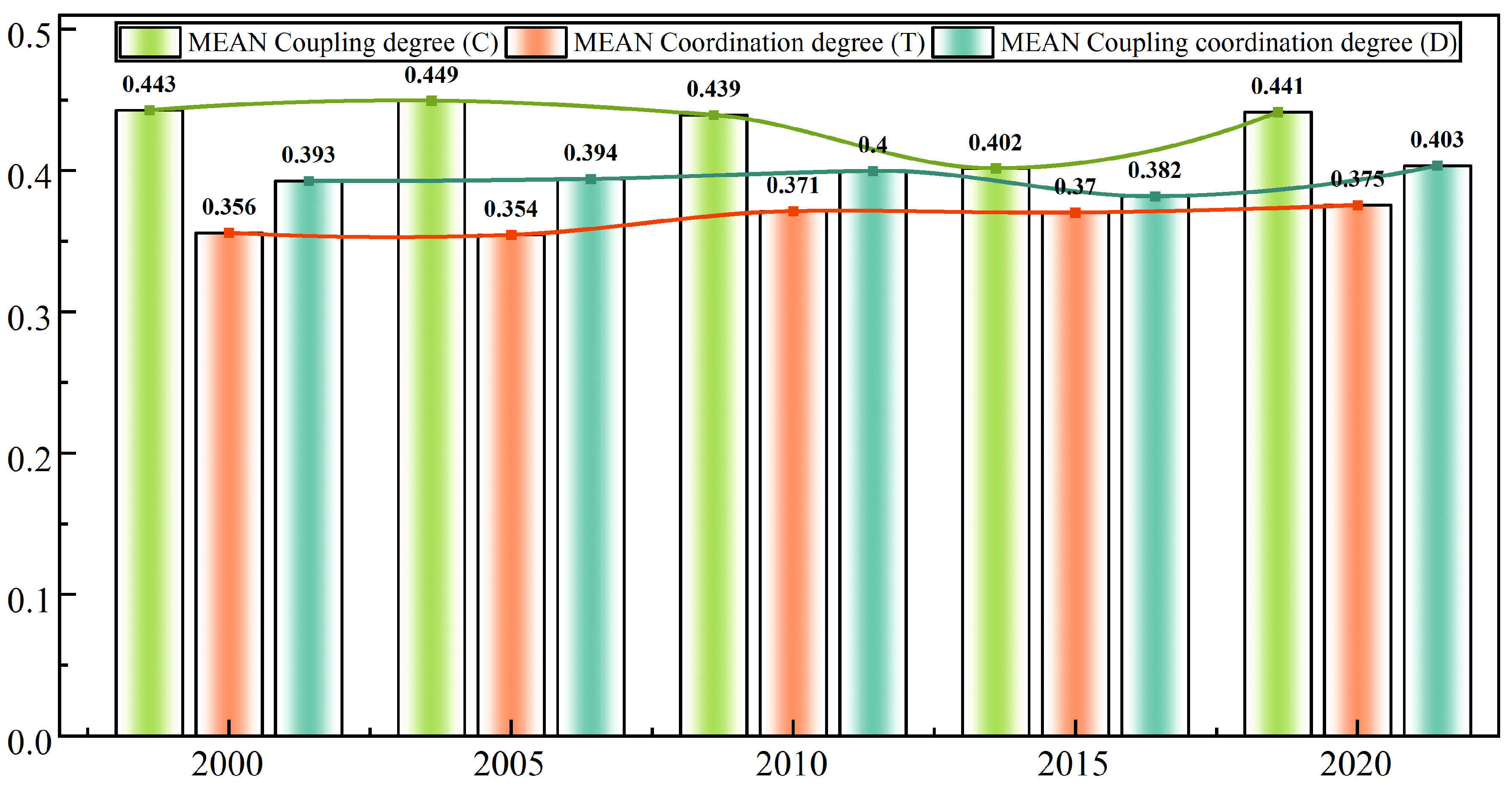

| Type | Formats | Precision | Data Sources | Source |
|---|---|---|---|---|
| Land use data | Raster | 30 m | China Land Cover Dataset [43] | https://zenodo.org/record/8176941, accessed on 10 May 2024. |
| Annual precipitation | Raster | 1 km | National Tibetan Plateau Data Center [44,45] | https://data.tpdc.ac.cn/, accessed on 16 December 2023. |
| Potential evapotranspiration data | Raster | 1 km | ||
| PM2.5 | Raster | 1 km | ||
| PM10 | Raster | 1 km | ||
| Plant root restricted layer data | Raster | 1 km | World Soil Information [46] | https://www.isric.org/, accessed on 10 May 2024. |
| Plant available water content data | Raster | 1 km | ||
| Copernicus DEM | Raster | 30 m | European Space Agency | https://panda.copernicus.eu/panda, accessed on 9 May 2024. |
| Soil conservation factor dataset | Raster | 1 km and 300 m | World Bank Open Data | https://www.scidb.cn, accessed on 10 May 2024. |
| NPP | Raster | 500 m | MOD17A3HGF Version 6.0 | https://e4ftl01.cr.usgs.gov/, accessed on 8 June 2024. |
| NDVI | Raster | 1 km | ||
| Population density | Raster | 1 km | World pop | https://hub.worldpop.org/, accessed on 16 December 2023. |
| Carbon emissions data | Raster | 11 km | Emissions Database for Global Atmospheric Research | https://edgar.jrc.ec.europa.eu/, accessed on 10 May 2024. |
| Administrative district | Vector | \ | National Geographical Information Resource Directory Service System | https://www.webmap.cn/main.do?method=index, accessed on 9 May 2024. |
| Other socio-economic data | Panel data | \ | Statistical yearbooks of corresponding provinces, cities, counties and districts | Government Gazette and Statistical Yearbook, accessed on 8 May 2024. |
| Goal | Sub-Dimensional Goals | Code | Localised Indicator | Indicator Direction | Weighting of Entropy Weights (Physics) | Coefficient-of-Variation Weights (CoV) | Combined Weights |
|---|---|---|---|---|---|---|---|
| Human well-being | Material well-being (MWB) | u1 | grain production | + | 0.388 | 0.171 | 0.280 |
| u2 | oilseed production | + | 0.105 | 0.385 | 0.245 | ||
| u3 | meat production | + | 0.363 | 0.374 | 0.368 | ||
| u4 | NPP | + | 0.144 | 0.070 | 0.107 | ||
| Ecological well-being (EWB) | u5 | Forest ecosystem area | + | 0.564 | 0.316 | 0.440 | |
| u6 | Area of aquatic ecosystems | + | 0.436 | 0.684 | 0.560 | ||
| Healthy well-being (HWB) | u7 | PM 2.5 | − | 0.175 | 0.129 | 0.152 | |
| u8 | PM 10 | − | 0.204 | 0.148 | 0.176 | ||
| u9 | Number of beds in medical institutions | + | 0.621 | 0.723 | 0.672 | ||
| Society well-being (SWH) | u10 | Public Finance Revenue | + | 0.408 | 0.442 | 0.425 | |
| u11 | Public financial expenditures | + | 0.288 | 0.298 | 0.293 | ||
| u12 | GDP | + | 0.304 | 0.260 | 0.282 | ||
| Resident well-being (RWB) | u13 | Average residential savings | + | 0.220 | 0.244 | 0.232 | |
| u14 | Average GDP | + | 0.085 | 0.068 | 0.077 | ||
| u15 | Number of students enrolled in secondary schools | + | 0.057 | 0.067 | 0.062 | ||
| u16 | Number of primary school pupils in school | + | 0.638 | 0.621 | 0.629 |
Disclaimer/Publisher’s Note: The statements, opinions and data contained in all publications are solely those of the individual author(s) and contributor(s) and not of MDPI and/or the editor(s). MDPI and/or the editor(s) disclaim responsibility for any injury to people or property resulting from any ideas, methods, instructions or products referred to in the content. |
© 2024 by the authors. Licensee MDPI, Basel, Switzerland. This article is an open access article distributed under the terms and conditions of the Creative Commons Attribution (CC BY) license (https://creativecommons.org/licenses/by/4.0/).
Share and Cite
Luo, Z.; Luo, S.; Zhang, F.; Yang, X. Spatial and Temporal Matching Measurement of Ecosystem Service Supply, Demand and Human Well-Being and Its Coordination in the Great Rivers Economic Belt—Evidence from China’s Yangtze River Economic Belt. Sustainability 2024, 16, 7487. https://doi.org/10.3390/su16177487
Luo Z, Luo S, Zhang F, Yang X. Spatial and Temporal Matching Measurement of Ecosystem Service Supply, Demand and Human Well-Being and Its Coordination in the Great Rivers Economic Belt—Evidence from China’s Yangtze River Economic Belt. Sustainability. 2024; 16(17):7487. https://doi.org/10.3390/su16177487
Chicago/Turabian StyleLuo, Zhijun, Songkai Luo, Fengchang Zhang, and Xiaofang Yang. 2024. "Spatial and Temporal Matching Measurement of Ecosystem Service Supply, Demand and Human Well-Being and Its Coordination in the Great Rivers Economic Belt—Evidence from China’s Yangtze River Economic Belt" Sustainability 16, no. 17: 7487. https://doi.org/10.3390/su16177487





